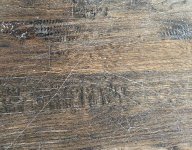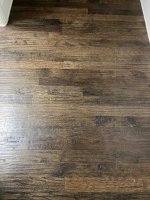Addendum: I was typing while Crazy posted. I agree, it should be far more durable. The “fix” I suggested originally (below) merely (if it worked) would hide the scratches. It would not add to the durability.
If you still have a dog, then carpet runners and area rugs will save your sanity. I would buy them from Lowes or Home Depot and spend $40.00 for an area rug. I would treat it as a consumable with a life of 12 - 18 months. Not only will it save your sanity, it is quieter and much safer for your dog, especially if it is a large dog like a German Shepherd or a Golden Retriever, etc.
We return you to our regularly scheduled programming . . .
When I moved into my Condo back in 1980, the oak floors were just finished. They apparently applied one or two coats of shellac.
There are a lot of good reasons for them choosing shellac, but durability is not one of them.
You can test to see if it is shellac by using alcohol on a rag in an inconspicuous place (I checked in the closet). If it rubs off, it is almost certainly shellac. In that case, you can either use a rag damp with alcohol to dissolve and blend the finish, or use Sealcoat to do the same.
From the seller’s point of view, shellac meant fast drying and minimal prep. Back then, water based finishes were not as good as they are today. And oil based finishes had a lingering odor. Shellac dries in an hour or so (I’ve recoated shellac in 20 minutes on warm dry days), and there is no lingering odor.
I am not suggesting that shellac is an ideal finish for floors, but if that is what is down now, then a fast and easy way to polish the scratches.
But note, the previous owner may have waxed the floor and that adds an entirely new wrench in the works.
The first step, in my opinion, is to test and see if it is shellac.



